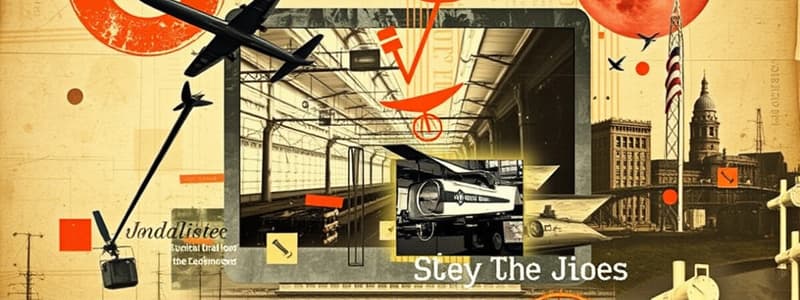Podcast
Questions and Answers
What percentage of U.S. B2B trade was e-commerce in 2015?
What percentage of U.S. B2B trade was e-commerce in 2015?
- 43% (correct)
- 60%
- 50%
- 20%
Social media is the fastest growing media for branding and marketing.
Social media is the fastest growing media for branding and marketing.
True (A)
What does EDI stand for?
What does EDI stand for?
Electronic Data Interchange
In 2017, M-commerce accounted for ___% of all e-commerce.
In 2017, M-commerce accounted for ___% of all e-commerce.
What are the main areas of growth in M-commerce?
What are the main areas of growth in M-commerce?
Which of the following is a feature of social e-commerce?
Which of the following is a feature of social e-commerce?
Match the following terms with their descriptions:
Match the following terms with their descriptions:
Crowdsourcing involves obtaining ideas or services from a large group of people.
Crowdsourcing involves obtaining ideas or services from a large group of people.
What is a private industrial network?
What is a private industrial network?
What is E-business?
What is E-business?
What is E-commerce?
What is E-commerce?
Which of the following are unique features of e-commerce? (Select all that apply)
Which of the following are unique features of e-commerce? (Select all that apply)
Business processes can be a source of competitive strength if they enable the company to innovate.
Business processes can be a source of competitive strength if they enable the company to innovate.
What are the four major enterprise applications?
What are the four major enterprise applications?
What is the role of the information systems function in a business?
What is the role of the information systems function in a business?
What are the principal e-commerce business models? (Select all that apply)
What are the principal e-commerce business models? (Select all that apply)
Which of the following is NOT a requirement for collaboration?
Which of the following is NOT a requirement for collaboration?
What does M-commerce stand for?
What does M-commerce stand for?
A company uses __________ systems to manage its relationships with suppliers.
A company uses __________ systems to manage its relationships with suppliers.
Match the following e-commerce business models with their descriptions:
Match the following e-commerce business models with their descriptions:
Flashcards are hidden until you start studying
Study Notes
Lab Assignment 1
- Individual quiz available in Moodle during week 4 lab.
- Closed book format with 5 questions similar to lab exercises.
- Time limit of 50 minutes for completion.
- Content based on lectures and labs from weeks 1-3.
- Attendance at the lab is mandatory for the quiz.
E-Business and E-Commerce Overview
- E-Business focuses on using digital technology to enhance major business processes.
- E-Commerce is a subset involving online buying and selling.
- E-Government utilizes technology for delivering information and services to citizens.
What are Business Processes?
- Defined as logically related activities that dictate how tasks are carried out.
- Involves the flow of materials, information, and knowledge.
- Business performance heavily relies on well-designed and coordinated processes.
Types of Business Processes
- Functional processes in manufacturing, sales, finance, and human resources.
- Example: Order fulfillment is cross-functional and requires coordination between different departments.
How Information Systems Improve Business Processes
- Increase efficiency by automating manual steps.
- Enable new processes and support new business models.
- Streamline decision-making through the elimination of delays.
Management Information Systems (MIS)
- Serve middle management, providing performance reports from transaction processing systems (TPS).
- Facilitate routine decision-making but typically lack analytical capabilities.
Decision Support Systems (DSS)
- Assist middle management in nonroutine decision-making.
- Can utilize external and internal data for improved insights.
Executive Support Systems (ESS)
- Aid senior management with nonroutine decisions requiring judgment and evaluation.
- Incorporate summarised internal and external data into digital dashboards for real-time insight.
Enterprise Applications
- Link various departments and streamline business processes across the organization.
- Include Enterprise Systems, Supply Chain Management, Customer Relationship Management, and Knowledge Management Systems.
Collaboration and Social Business
- Collaboration involves joint efforts across organizations to achieve goals.
- Social business utilizes social networking platforms to enhance engagement with employees and customers.
- Emphasizes information transparency and the generation of user-created content.
Benefits of Collaboration
- Enhances productivity, quality, innovation, customer service, and financial performance.
- Foster a collaborative culture within organizations to value teamwork and lower-level participation.
Tools for Collaboration
- Include email, instant messaging, wikis, and platforms like Microsoft SharePoint and cloud services.
The Information Systems Department
- Usually led by a Chief Information Officer (CIO).
- Comprises various roles including programmers, systems analysts, and end users.
Unique Features of E-Commerce
- Ubiquity, global reach, universal standards, richness, interactivity, and personalization/customization.
- Digital markets enable transactions that reduce information asymmetry and associated costs.
Types of E-Commerce
- Includes Business-to-Consumer (B2C), Business-to-Business (B2B), and Consumer-to-Consumer (C2C) models.
E-Commerce Business Models
- Portals serve as gateways to the web; e-tailers sell physical goods.
- Content providers offer online digital content; transaction brokers process transactions.
- Service providers deliver applications; community providers create social platforms.
E-Commerce Revenue Models
- Advertising, sales, subscription, free/freemium, transaction fees, and affiliate marketing are the primary models.
- Each model varies in strategy and pricing, impacting revenue generation.
Transformation of Marketing by E-Commerce
- Internet enables targeted marketing, native advertising, behavioral targeting, and personalized user experiences.
Business-to-Business (B2B) E-Commerce
- B2B trade was valued at $14.6 trillion in 2015, with $6.2 trillion attributed to e-commerce.
- Utilizes technologies like Electronic Data Interchange (EDI) and private industrial networks to automate procurement.
Private Industrial Networks and Net Marketplaces
- Private industrial networks link large firms to suppliers; net marketplaces provide singular digital spaces for buyers and sellers.
The Role of Information Systems
- Critical for integrating and managing information across business functions and enhancing overall organizational performance.### Role of M-commerce in Business
- M-commerce accounted for 37% of all e-commerce in 2017, marking it as the fastest-growing segment within online transactions.
- Certain areas of m-commerce are experiencing growth rates exceeding 50%.
- Key sectors driving m-commerce growth include:
- Mass market retailing (prominent players: Amazon, eBay)
- Sales of digital content (music, TV shows, etc.)
- In-app purchases from mobile devices
Location-Based Services and Applications
- Approximately 74% of smartphone users utilize location-based services.
- Services rely on GPS technology:
- Geosocial services enable users to see the locations of friends.
- Geoadvertising provides information about nearby shops and promotions.
- Geoinformation services deliver localized information such as real estate prices for properties users are passing.
Other Mobile Commerce Services
- Financial management apps are frequently used for banking and credit card services.
- The mobile advertising market is dominated by major players like Google and Facebook.
- Advertisements are integrated into games, videos, and mobile applications.
- 55% of online retailers have developed m-commerce websites to reach customers.
Issues in Building an E-commerce Presence
- Essential management challenges include:
- Formulating a clear understanding of business objectives.
- Selecting appropriate technology to meet those objectives.
- Creating an e-commerce presence map is crucial, encompassing:
- Websites
- E-mail communications
- Social media engagement
- Offline media strategies
- Establishing a timeline with milestones helps break down the project into manageable phases.
Studying That Suits You
Use AI to generate personalized quizzes and flashcards to suit your learning preferences.




